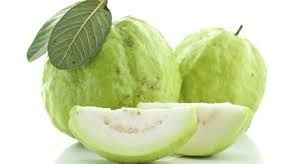If">www.ehow.com/info_11400493_guava-fruit.html">f you don't live in a tropical climate, you may find guava to be not only exotic, but a bit of a mystery. There is such a wide variation in almost every aspect of the fruit that it is difficult to describe it in general terms and still cover all of its permutations. One thing all the varieties do have in common is their nutritional benefit. Guavas are high in fiber and in vitamins A, B and C.

Description">www.ehow.com/info_11400493_guava-fruit.html">Description
Guava">www.ehow.com/info_11400493_guava-fruit.html">Guava fruits are actually berries. According to the University of Florida IFAS Extension, common guava fruits are usually 2 to 4 inches long, have four to five bumps on their blossom ends and can weigh anywhere from 1 to 48 oz. Guava fruits may be round, egg- or pear-shaped. In addition, they may lack seeds, have soft seeds that are edible or have brown seeds that you must remove before eating.
Peel">www.ehow.com/info_11400493_guava-fruit.html">Peel
Guava">www.ehow.com/info_11400493_guava-fruit.html">Guava peels are generally green or yellow. Their thickness varies by cultivar and may be thick or thin. Common guavas, also known as apple guavas, are yellow when ripe. They may blush pink when ripe and have thin skin. Guavas also have a variety of aromas, including strong, mild and pleasant. Common guavas smell musky and sweet when they're ripe.
Pulp">www.ehow.com/info_11400493_guava-fruit.html">Pulp
The">www.ehow.com/info_11400493_guava-fruit.html">The flesh of guavas may be white, yellow, red or pink in color and sweet to acidic in flavor. You can eat guavas with white pulp while they are still unripe, green and crispy. However, you must cook or process guavas with an acidic flavor before eating. You can eat sweet guavas with pink or red pulp once they ripen or any sweet and mild-flavored guavas, regardless of pulp color, while they are raw. You can tell when guavas ripen by applying slight pressure to the peel. If it gives under the pressure, the fruit is ready.
Handling">www.ehow.com/info_11400493_guava-fruit.html">Handling
Handle">www.ehow.com/info_11400493_guava-fruit.html">Handle guavas carefully, as they bruise easily. Store unripened guavas at room temperature, and place them in a container with apples to help them ripen. Preserve guavas through canning, and use the fruits in salads and desserts as juice, nectar, syrup and jelly.
U.S">www.ehow.com/info_11400493_guava-fruit.html">U.S. Guavas
Guava">www.ehow.com/info_11400493_guava-fruit.html">Guava fruits are common to tropical and sub-tropical regions. While guavas now grow in parts of California, Texas, Florida and Hawaii, they are not native to the U.S. Common cultivars include Ruby, valued for its sweet flavor, lack of seeds and multiple uses and the medium-sized Patillo, which is used in cooking.
Other">www.ehow.com/info_11400493_guava-fruit.html">Other Guavas
In">www.ehow.com/info_11400493_guava-fruit.html">In addition to common guavas, other species include the Cattley guava or strawberry guava, which produces up to 1 1/2-inch-long, strawberry-flavored red to reddish-purple fruits. Pineapple guavas look like guavas and are named for the fruits but are not actually guavas. They are kiwi-sized fruits, usually used fresh. Wild guavas are processed for use because they are sour.




